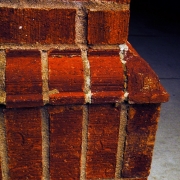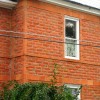LECA Masonry
Light Expanded Clay Aggregate (LECA) masonry block, which was used in the construction of the Landskrona Townhouse, is a low embodied energy material, is relatively inexpensive, is lightwieght, has a high insulation R-value, and is made by heating the materials to 1200 degrees Celsius in a rotary kiln. The origins of LECA and other aggregates such as Gravelite, Perlite, and Rocklite can be traced back to the invention of Haydite (invented for the construction of the USS Selma) in 1917 in Kansas City, Missouri. In Europe, LECA block was first used in Denmark, Germany, Holland, and the U.K.




